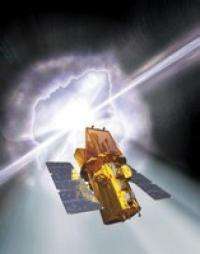Space telescopes reveal previously unknown brilliant X-ray explosion in our Milky Way galaxy

Astronomers in Japan, using an X-ray detector on the International Space Station, and at Penn State University, using NASA's Swift space observatory, are announcing the discovery of an object newly emitting X-rays, which previously had been hidden inside our Milky Way galaxy in the constellation Centaurus.
The object -- a binary system -- was revealed recently when an instrument on the International Space Station named MAXI (Monitor of All-Sky X-ray Image) on the Exposed Facility of the Japanese Experiment Module "Kibo" caught it in the act of erupting with a massive blast of X-rays known as an X-ray nova. The MAXI mission team quickly alerted astronomers worldwide to the discovery of the new X-ray source at 2:00 a.m. EDT on 20 October, and NASA's Swift Observatory quickly conducted an urgent "target-of-opportunity" observation nine hours later, which allowed for the location of the X-ray nova to be measured accurately.
"The collaboration between the MAXI and Swift teams allowed us to quickly and accurately identify this new object," said Jamie Kennea, the Swift X-ray Telescope instrument scientist at Penn State University who is leading the Swift analysis. "MAXI and Swift's abilities are uniquely complementary, and in this case have provided a discovery that would not have been possible without combining the knowledge obtained from both."
The Swift detection confirmed the presence of the previously unknown bright X-ray source, which was named MAXI J1409-619. "The Swift observation suggests that this source is probably a neutron star or a black hole with a massive companion star located at a distance of a few tens of thousands of light years from Earth in the Milky Way," said David Burrows, professor of astronomy and astrophysics at Penn State and the lead scientist for Swift's X-ray Telescope. "The contribution of Swift's X-ray Telescope to this discovery is that it can swing into position rapidly to focus on a particular point in the sky and it can image the sky with high sensitivity and high spatial resolution."

"MAXI has demonstrated its capability to discover X-ray novae at great distances," said Kazutaka Yamaoka, assistant professor at Aoyama Gakuin University and a member of the MAXI team. "The MAXI team is planning further coordinated observations with NASA satellites to reveal the identity of this source."
Provided by Pennsylvania State University
















